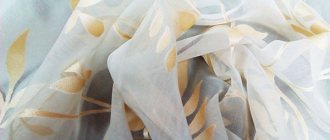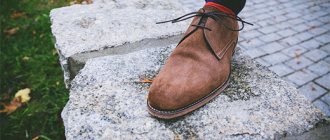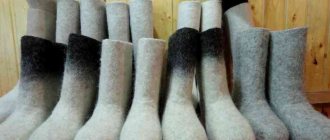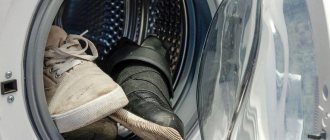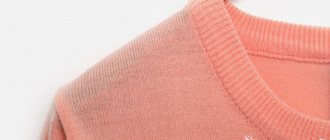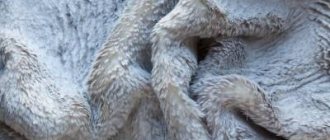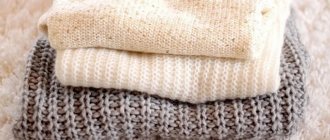Soft, elastic, velvety to the touch, suede is an excellent basis for creating amazingly beautiful, stylish things.
Clothes, shoes, and accessories made of suede will delight you for many years, provided they are properly cared for.
How to care for suede products, can they be washed in a washing machine? How to soften and restore suede items?
The answers to these questions will help you preserve the original appearance of your favorite things for as long as possible.
How to soften suede after washing
Despite the fact that suede is not only beautiful, but also quite practical material, it has a significant drawback. Over a certain period of time, comfortable and attractive things lose their luster. You can restore a decent appearance to such products by simply washing them by hand or in a washing machine, following certain rules. In this case, a problem often arises - suede loses its primary softness. What needs to be done to soften it. Experts offer several ways to soften the material.
Brush selection
The hardware store sells a special double brush for cleaning suede. One side is covered with rubber or rubber fingers, the other with hard bristles. It is advisable to purchase just such an item for cleaning a suede jacket. Costs 300-400 rubles.
You will also find more budget-friendly types of products:
- regular clothes brush;
- kitchen sponge with a hard top layer;
- school eraser;
- old toothbrush;
- fine-grained sandpaper.
Useful tips on how to soften suede
- The suede is steamed over steam. The process itself requires scrupulousness and accuracy. Under no circumstances should the item fall into boiling water. Otherwise, the product will deteriorate (the suede will shrink). As a washing option, leave suede items in the bathroom with a hot shower running for half an hour, no more. The suede softened in this way is thoroughly dried naturally, without resorting to any heating devices. The dried item is steamed again. To achieve the desired softness, the softening procedure is repeated at least five times. Suede will indeed become a soft material.
- softened shoes tightly with paper. This is done so that the soft material does not shrink when drying.
- Suede can be softened with a vinegar solution. You should prepare it yourself by dissolving one teaspoon of vinegar essence in one liter of water. If you have 5% or 9% vinegar, you should take one tablespoon. The hardened suede fabric is wiped several times with a soft sponge soaked in the resulting solution. Ammonia is also used with the same effect.
- If after the manipulations the softness of the product is not restored, you should resort to the following method. You need to prepare a glycerin mixture. Its composition is obtained by mixing half a teaspoon of glycerin with a liter of water. Once pre-shaken, moisten a soft cloth and apply it to the suede, allowing the solution to be absorbed. Excess should be wiped off with a dry cloth.
- You can use an iron with a steam function. The suede item should be hung on hangers and the sole should be passed over the surface of the suede at a distance of two centimeters. The procedure is not quick to achieve the desired result.
The main recommendation for owners of suede products is to regularly care for things made from such a delicate material, not to allow it to change too much, when even with all your efforts it will not be possible to return it to its original condition. You can extend the service life of suede items by using protective products for this material.
Causes of the defect
Hard leather and a heel are, in fact, a defect that, unfortunately, cannot always be determined when trying on.
Hard shoes that rub your feet can make you angry for a long time
Sometimes a pair becomes rough after wearing it. There are two reasons for the shortage:
- low-quality materials;
- wrong block.
In both cases, the blame falls on the shoulders of the manufacturer. However, you can return hard shoes and hope for a replacement or compensation only if 2 weeks have not passed from the date of purchase.
Legal 14 days
According to current legislation, shoes that do not fit for any reason can be returned to the store within 14 days from the date of purchase.
Within 2 weeks you have the right to return a pair that does not suit you
To issue a return (or exchange), the buyer must provide a cashier's receipt (possibly a copy of it), a coupon for the pair's warranty service and his passport. Only the product must meet a number of requirements:
- be without signs of being worn on the street (for our situation this is hardly possible, because you can only rub your feet while wearing it);
- have the proper appearance, that is, without creases, abrasions, etc.;
- be in the original configuration (with heels, insoles, etc., in a box).
How can I fix the situation with hard shoes?
The problem of shoe stiffness can be solved quite easily: you need to contact a workshop.
The shoe repairman has all the necessary means to soften the material
True, if there are a few “buts”:
- not all specialists will take on this task;
- sneakers and sneakers with rubber soles and toes are not the most “desirable” clients;
- No craftsman can guarantee that leather shoes will not change in size.
In other words, if you have problems with a leather pair and increasing it by 1–1.5 sizes will only make you happy, then feel free to look for a shoe workshop. In other cases, it is better to turn to traditional recipes.
Properties of artificial and natural suede
Natural suede has the following qualities:
This material is obtained by combined tanning of sheep or deer hides (cattle are allowed). This material absorbs moisture, and after swelling it becomes almost waterproof. It is a good, comfortable and breathable fabric. In appearance, it is a pile material, so products made from such suede are distinguished by velvety, and in softness it is very similar to fabric.
I work in the household appliance repair industry. Extensive experience in restoring washing machines and dishwashers.
Artificial suede is produced differently from natural suede. It is, if you can call it that, synthesized. Faux suede is made in two ways - woven and non-woven. When produced using the woven method, the material is of very high quality and reliable, it retains its strength and flexibility. The essence of this method is special microfiber threads. They are used to weave material for future suede, after which it is passed through a special machine that creates pile on the fabric. This is how quality material is obtained. True, this method is very expensive and not accessible to everyone.
Another option for producing artificial suede is the non-woven method. It is based on the technology of gluing pile onto fabric. This material is of the lowest quality, but in appearance it is very similar to suede, so it can be confused with natural. In order to distinguish these two types, you need to pay attention to the inside of the fabric. If there is a difference with the outside, this means that the suede was produced using a non-woven method.
Handwash
If you decide to wash your suede product by hand, you should know that it loves care. Washing should be done carefully and quickly. Under no circumstances should things be soaked for a long time. This material does not like this attitude.
- Fill a container with warm water.
- Add laundry detergent or suede shampoo.
- Soak the item briefly.
- Take a brush and begin to gently and carefully rub, starting from those places that are most dirty.
- When finished, drain the soapy water and gently wring out the product.
- Fill up with new water without detergent and rinse your item. It is necessary to rinse until the water in the container becomes clear.
- Squeeze lightly and hang to drain and dry.
Do not squeeze too hard, this will damage the material. And if your suede was obtained using a non-woven method, then you shouldn’t get the whole thing wet at all.
Dilute soapy water and scrub the dirty part with a foam sponge. Afterwards, treat in the same way only with a clean sponge to rinse.
Dry cleaning
This type of washing is the optimal way to clean suede products. In addition to the fact that this is a noble material and prefers dry cleaning, some products made from it cannot be washed at all. If on the label of the item you find a symbol prohibiting washing, congratulations, you will have to use dry cleaning using the methods outlined below.
Ethanol
It is good for removing makeup or greasy stains. Despite the fact that ethyl alcohol is essentially an aggressive substance, it is good for removing such contaminants or, for example, a shiny area. Instructions:
- wet a piece of clean cloth with alcohol;
- treat the stain until it disappears;
- let things dry.
Soap solution
Another possibly suitable option. It is unlikely that grease can be removed this way, but simple mud stains can be removed. And this is done like this:
- To begin with, you need to use a rubberized or regular brush to remove dirt from the area that needs to be cleaned.
- Then, dilute a weak soap solution of laundry or baby soap in a container.
- Soak a cloth, rag or sponge in the mixture and apply it to the area to be cleaned.
- Then, in the same way, remove any remaining soap (rinse).
- Leave to dry.
We restore suede products
Method 1. Returning the color
A spray matched to the shade will help restore the color of suede shoes. You can buy it at a shoe store - the price is affordable.
How to use the spray:
- Spray the product at a distance of 20 cm from the shoes.
- Dry it.
- Raise the pile with a brush.
To avoid contaminating the floor with small splashes, cover it with oilcloth. If possible, treat your shoes outside.
Method 2. Paint with coffee grounds
You can restore brown suede boots using coffee grounds:
| Illustration | Instructions |
| Step 1 Coffee grounds are applied to the suede surface. Leave the product for 15–20 minutes. | |
| Step 2 The remains are then removed.
|
Method 3. Remove stains and scuffs
Suede items easily absorb dust and dirt. The appearance becomes even worse when the pile is crushed, gloss and scuffs appear.
I recommend using affordable and simple substances to restore the previous condition, leaving the fabric undamaged:
| Illustration | Recommendations |
| Milk and soda. Restoring suede on shoes is possible if you wipe the polished area with this compound. | |
| Vinegar solution . Helps restore suede shoes. Be sure to rinse the product with water after this. | |
| Fine salt . You can renew suede by rubbing the product with fine salt. | |
| Steam. Steam can update suede shoes with your own hands. To do this, you need to hold the product over boiling water or steam it with an iron without touching the sole to the material. |
After treating the shoes with any product or solution and drying them completely, clean the problem areas with a brush. This way the structure of the material is restored.
Method 4. Removing a greasy stain
Difficult to remove greasy stains pose a danger to things. There are effective methods to combat them.
Grease stains can be easily removed with purified gasoline
:
Contaminants are removed well with stain remover:
- treat the stain;
- After waiting a little, remove the residue with a brush;
- refresh by combing.
Suede UGG boots - before and after cleaning with stain remover
You can refresh your suede shoes with an eraser,
gently rubbing the stained area.
How to soften suede
Effectively looking suede has its own service life. While you wear it with pleasure, it gradually becomes dirty, dull, shaggy and rough. If you notice dirt on something when you look at it, the roughness is felt by the skin and restricts movement. We noticed that something is wrong with the suede, it is no longer soft, has lost its elasticity - it’s time to get to work.
- How do you initially soften the skin? It is soaked in special solutions and then crushed. In the old days, this was done manually by tanner shops. No one is forcing you to follow their example, especially since you have neither the skills nor the strength. Leather, of which suede is a type, should not be wrinkled at home. If it has become rough when worn, unnecessary movements will not help it.
- Suede perfectly absorbs moisture and restores lost softness. But there is no need to rush to dip the item into the bath. Steam treatment will be sufficient. And you shouldn’t grab an iron to iron and steam the suede. If you have already chosen this household appliance with a steaming function, then hang up your jacket or lay out your accessories and shoes and walk the sole a couple of centimeters from the surface of the suede. Not once, not twice, not three times, it will take 5-6 passes for the material to become soft.
- A method with steam, but not requiring your direct intervention, is to hang a suede item over a steaming boiling container, pan or kettle, for example. And leave it for half an hour, no less. Let it warm up and soak in moisture. Another option is to leave things to steam in a closed bathroom, where hot water is running (or poured into the bath). After water treatments, the suede will regain its shape; it will need to be dried and combed with a special brush (for the care of this particular material).
- Vinegar has a restorative and cleansing effect on suede. All you need to do is dilute a tablespoon of solution (9% or 5%) in a liter of clean water at room temperature. Then soak a soft sponge or cloth in the product and wipe the item with it several times. Vinegar will soften the structure and get rid of any unexpected impurities.
- Ammonia has a qualitative effect on softening suede. Perform the same actions as with the vinegar solution - and get the desired result.
- If vinegar and ammonia do not live up to your hopes, glycerin will come to the rescue. It will take half a teaspoon per liter of water. Shake it out, apply it to the suede with a cloth, and let it absorb. Wipe off the remaining glycerin solution with dry cloths or a soft cloth.
Now the suede is sure to change its anger to mercy and become softer. True, it won’t bring back a new look, but it will serve for a long time.
Greasy places
Greasy stains on your jacket can be cleaned using simple home remedies.
How to clean:
- Ideal for light-colored material is a serum prepared from an aqueous solution of ammonium hydroxide and water. The components are diluted in a ratio of 1:3. Take a little ammonia so that you don’t have to pour out the excess. This will reduce ammonia consumption. A soft cloth is moistened in the prepared solution and the greasy areas are wiped. After which you will need to clean the treated areas with fine-grained sandpaper or go over them with a special brush for suede.
- Vinegar will help get rid of such contamination. It is diluted 50:50 with clean boiled water. Armed with a brush and this solution, they begin to treat the greasy areas.
- The most reliable option is a steam iron and a rubber brush. First, steam is passed over the product, and then with a rubber brush. This will remove dirt and put the item in order.
After such procedures, you don’t need to think about how to wash your suede jacket to get it in order.
How to expand suede shoes yourself
Any shoes, regardless of the material from which they were made, are subject to mechanical stress when worn. For this reason, the product begins to increase. When the question arises of how to stretch suede shoes, it is not recommended to choose the breaking-in method as a priority. While the material takes on the required shape and size, corns and blisters may appear.
To stretch the shoes, you need to soften the suede. Only this technique will allow you to safely enlarge the product.
Soaking with water
To stop boots or shoes from squeezing your feet, you can try to increase them by soaking them. To do this, you need to wet a clean napkin with water, wring it out (so that it doesn’t drip) and wipe the inside well. It is not recommended to wet suede material on top, because its appearance may change. After treatment with water, the shoes are put on. You need to walk around the room in it, but not for long. Staying in tight shoes for a long time can cause foot injuries. To get the desired result, the manipulation will need to be repeated several times.
Shoes made from artificial suede will not absorb moisture as intensely as those made from natural material. For this reason, you should treat it with a wet cloth several times so that the product absorbs water well, and then put it on.
Putting on wet socks
Soaking can be done using socks. This method will give a positive result faster than the previous one, but you should be careful. The product can stretch greatly, and then you will need to look for a way to make suede shoes smaller.
To do this, soak cotton socks in warm water. If shoes put a lot of pressure on your feet, it is recommended to take a product made of dense material. After spinning, the socks are put on your feet and put on your shoes. To break in suede shoes that are too tight, you will need to spend about 2-3 hours.
How to remove grease stains?
A suede jacket is a capricious thing. Do not use chemical stain removers to clean it. Home remedies will again come to the rescue. The principle of operation of most of them is based on the fact that absorbent particles absorb fat, so the dirty mark disappears.
Sprinkle the stain generously with one of the following:
- coarse salt;
- talc;
- crushed chalk into powder (to match the color of the jacket);
- tooth powder.
To enhance the effect, you can add 1-2 drops of ammonia. Leave the product on for 2-3 hours so that it absorbs the fat. Remove the powder with a brush. To consolidate the result, wipe the treated area with a cotton pad soaked in a weak solution of vinegar (1 teaspoon per liter of water). When the jacket is dry, straighten the lint with the rubber side of the brush.
What should you do if there is an old greasy stain on your jacket that doesn’t want to come out? Try a radical remedy - gasoline (it is an excellent solvent). First check the action on the reverse side of the product. We do not recommend using a synthetic suede cleaner.
Apply 1 teaspoon of gasoline to the greasy stain and scrub the product with a brush. Rinse off stains with water. Send the jacket outside to dry so that the pungent smell completely disappears.
How else to stretch individual parts of suede shoes
If you don’t want to increase your size or you couldn’t cope with the problem of tight shoes on your own, you can use the services of a workshop. In this case, special blocks will be used for stretching, which allow you to increase the length and width of the product mechanically.
How to stretch the boot top
The inner surface of the shaft of suede boots can be increased using an iron. It is necessary to unfasten the zipper and place the product on a flat surface. On top it must be covered with a flannel piece of fabric, which is first soaked in water, and then the excess moisture is squeezed out.
When the preparatory stage is completed, you need to iron the suede with an iron and steamer, and then let it cool on its own and dry completely.
How to break in new shoes
Sports shoes, like sneakers, should not be too tight. During sports or long walks, it can cause many inconveniences. Therefore, if you have just purchased sneakers, before using them for the first time, you should wipe them from the inside with table vinegar, put on socks and walk around for several hours. The smell of vinegar will disappear on its own.
How to widen tight shoes
When boots compress your feet, you can try to expand them with hot water. It is not recommended to pour boiling water inside the product. To prevent deformation, you should pour hot water into a tight plastic bag, the temperature of which is +60...+70°C. You need to work carefully so as not to get burned. Packages filled with hot liquid are placed inside the product. After 5-7 minutes they are taken out and socks and shoes are put on your feet.
This method allows you to quickly make tight boots loose.
How to stretch a sock that is too narrow
Besides the shin, a common place that causes discomfort is the toe of the boot. To expand it, you should heat the surface of the suede with a hair dryer, and then try to knead the soft velvety skin with your hands. After this, the shoe is reheated, but already put on the foot. After cooling, the product is removed.
How to soften a back that is too hard
If the shoe is the correct size, but its heel is too hard, a hammer or other similar object can help soften it. Cover the problem area of the shoe or shoe with a damp cloth and then gently tap the surface. Do not hit the product too hard with a hammer.
Another way to solve the problem is to use vegetable oil. They need to process the inside of the backdrop. Soap or wax can achieve the same result. Rub the inside surface with them, leave for 12-14 hours, and then wipe with vinegar.
Are you earning enough?
Check if this applies to you:
- there is enough money from paycheck to paycheck;
- the salary is only enough for rent and food;
- debts and loans take away everything that is obtained with great difficulty;
- all promotions go to someone else;
- you are sure that you are paid too little at work.
Perhaps your money has been damaged. This amulet will help relieve lack of money.
Suede
– the most difficult to care for and capricious material. The same applies to similar nubuck and velor. How to care for suede shoes so that they retain their attractive shape for a long time?
Proper care guarantees an exquisite appearance, neatness and durability of the product. Rain, slush, snow, salt and sand negatively affect the quality of shoes.
To keep your boots, pumps, moccasins, sneakers, boots and flats looking great, you need to use the right products and be careful when storing your shoes.
How to clean suede shoes at home
It is not necessary to immediately take soiled shoes made of natural suede to the dry cleaner - they can be easily cleaned at home. Faux suede is also easy to clean with your own hands.
This material is used for autumn-spring (demi-season) products, so it has to be cleaned of dirt and slush.
In the summer, sandals, shoes, sneakers, sneakers suffer from dust. All these contaminants can be easily removed using either special store-bought shoe cleaning products or simple household ones: soap, alcohol.
Special products for cleaning suede
How to clean suede? There are large lines of care products for this easily perishable material. They include the following products:
Cream foam spray lotion shampoo “eraser” brush impregnation
Ideally, you should have at least a few of the above products at home, since each is used for specific needs.
For example, foam can quickly remove shallow dirt, refresh the appearance of boots before going out (especially in spring), and cream is intended for intensive cleaning. Water-repellent shoe spray is used to protect against hazardous environmental factors.
How to raise the pile on suede shoes? Use a rubberized brush. The prices for all these products are low - for a thousand rubles it is easy to buy a set of products that will last for a couple of seasons.
How to properly care for suede shoes? Buy only quality products to clean your boots. The best manufacturers of suede care products:
Avel Salton Tarrago Collonil Salamander Steam
The simplest, yet incredibly effective method for cleaning suede material is steam. The method is very simple. It will not require anything from you except a large capacity:
Boil water in a basin, saucepan or any other large container. Without lowering the heat, remove the lid. Hold the boots over the container for about two minutes to allow them to become steamed.
Simply wipe them with a dry cloth or lint-free cloth.
This method will allow you to easily get rid of small and minor dirt. Ammonia
To wash suede with this product:
1. Dilute water and alcohol in a ratio of 1 to 4 in a basin or bowl. 2. Dip a clean sponge into this mixture. 3. Gently dry your boots. Try not to get the product wet through – suede does not like high humidity and long drying times. 4. Rub a dry, clean sponge over the material. 5. Dry your shoes. This method works well against stubborn dirt or old stains.
How to care for nubuck shoes in winter
In winter, boots are subject to increased stress. Snow, coating, sand, dirt will easily ruin them. How to properly care for suede shoes at this time of year? The most important rule to follow is to be sure to wipe and dry your shoes after a walk.
Accumulated snow is a threat to suede and similar leather materials. When it melts, the shoes will get wet through and through, and at best, light stains from a mixture of salts and other chemicals will form on them; at worst, they will lose their shape.
Don't forget to treat your boots with water-repellent and protective spray.
Is it possible to wash suede shoes?
Since suede is a very delicate and capricious material, it is not recommended to wash it. If you cannot do without washing (the shoes are very dirty), then you will have to adhere to strict rules so as not to spoil the product:
Try not to get the inside of your shoes too wet. When doing a full wash, it is difficult to adhere to this rule, but try not to get the product wet through. Suede does not react well to high humidity, and you cannot leave it wet for a long time - the shoes will lose their shape.
Machine washable is out of the question. Suede products are washed only by hand. Even if you have a modern unit with a delicate mode, it’s not worth the risk. Hand washing will take you a lot of time, but the result will be clean and undamaged shoes.
Do not use aggressive cleaning agents. Washing powders will not work. To wash your boots, it is better to use a mild soap solution. It’s very simple to prepare: pour warm water into a large container, add liquid soap until a thin foam appears on the surface (one pump is enough).
Thanks to the weak solution, there will subsequently be no light streaks or stains left on the material, as could happen with washing powder.
Start drying immediately after washing. Remember - suede, velor, nubuck and other materials based on tanned leather cannot be kept near a heater, radiator, or treated with a hot hairdryer. It is better to wipe the surface with a dry sponge or napkin, and then leave it to dry, covering it with newspaper. How to restore suede shoes at home
If the suede product has been heavily soiled, stained or stained, then simple cleaning may not be enough.
How to restore the color of suede shoes?
Buy special paint for it. How to paint boots, update them, and save their original appearance:
Choose your paint carefully. Pay attention not only to the manufacturer and price tag, but also to the color. It must exactly match the shade of the material, otherwise it will not be possible to paint evenly. Paint for suede shoes in black tones is easy to select, but a little more difficult for brown ones. You need to be especially careful when buying a product for white and beige products.
Before completely processing the product, test the paint on the most inconspicuous area, for example, on the inside. Dye a small piece of suede and wait a few hours to check the color and reaction of the material. Once you are sure that the shades of the product and the shoes match, you can process the entire product. Restoration will take a long time. Take your time, apply the paint patiently and carefully so that the layers absorb well. How to store
In order for suede and other similar materials to serve you for many years, you need to store them properly. Shoes made from tanned leather are very sensitive to temperature and air humidity, so if stored improperly, they can quickly lose their shape and beautiful appearance. To protect your boots from this, follow these simple rules:
Tall suede boots should never be bent or folded in half. The shoes will remind you of this with ugly stripes on the top.
Boots, ankle boots and other winter or demi-season footwear made of suede, nubuck or velor must be stuffed with newspaper or other filler during storage so that they do not lose their shape.
When you plan to put your shoes away until next year, be sure to thoroughly clean and dry them.
Video: how to care for nubuck
In the video below, the presenter describes in detail and clearly all aspects of caring for suede shoes: the correct selection of products and their use, rules for storage, drying and cleaning.
You will learn how to care for suede boots and how to clean nubuck and velor shoes. You can purchase all the products used by the presenter in regular Russian supermarkets.
What affects our mood? There may be a thousand answers to this question, but comfortable shoes will probably be in the top ten. After all, if your shoes rub, no amount of joy in life can distract you from the pain. The reason for such discomfort is very often the rigidity of the material from which the pair is made. But you shouldn’t despair - there are several options to turn the situation in your favor. That is, you can’t rub your feet and show off your beautiful shoes. Let's look at the most effective means of softening shoes.
What not to do
Do not use aggressive substances, because they can damage the material or ruin its color. You shouldn't get your shoes too wet either. Wetting suede can cause deformation of the product. You can ruin your shoes if you immediately try to stretch the shoes too much.
At the time when attempts are made to make the size larger on your own, you should not go outside, i.e. take long walks. Wet suede material will attract dirt.
Do not dry soft, velvety skin near a radiator or other heater. Even if the shoes were the appropriate size, after this procedure they may become tight.
It is not recommended to entrust the increase by wearing it in to another person whose feet are larger. Such actions may result in the product becoming larger than necessary.
Proper drying
Drying the material is possible and even recommended at normal room temperature. The fact is that with greater heating, insufficient humidity and prolonged treatment at high temperatures, suede deteriorates and dries out. As a result, it becomes rough, cracks and fails.
Therefore, it is strictly forbidden to dry suede items near heaters. Simply hang the product in a room or place to dry and leave it overnight. This is a smart approach.
If you washed a suede bag, shoes or some other bulky wardrobe item, then you will need paper. It needs to be shoved inside a shoe or bag. This move is necessary to absorb moisture from the inside and maintain the shape of the product.
LiveInternetLiveInternet
—Applications
- always no analogues at hand
^_^ Allows you to insert a panel with an arbitrary Html code into your profile. You can place banners, counters, etc. there - Cheap flights
Favorable prices, easy search, no commission, 24 hours. Book now - pay later!
—Tags
—Categories
- applications (13)
- felting (3)
- second life of things (39)
- knitting (10)
- steamed (5)
- decoration (10)
- women's things (26)
- magazines (4)
- home ideas (38)
- leather (29)
- preservation (21)
- beauty and health (9)
- cookbook (52)
- baking (16)
- mushrooms (1)
- fish (12)
- salads (2)
- landscape design (14)
- little tricks (9)
- fur (14)
- my work for the soul (30)
- shoes (15)
- newspaper weaving (19)
- your own business (5)
- bags (133)
- decorations (4)
- fabric flowers (20)
- what else to drink (8)
- sewing (83)
- hats (16)
- for men (6)
- curtains (17)



